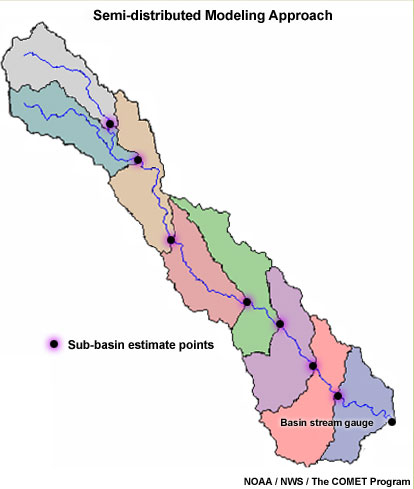Semi-Distributed Modeling

Semi-distributed modeling is a variation of the lumped method and is sometimes referred to as a "pseudo-distributed"� approach. Using this approach, a basin is broken down into smaller sub-basins. Runoff amounts from methods such as unit hydrograph are used to estimate streamflow from each of these sub-basins. These runoff volumes are then routed downstream to estimate the streamflow output for the larger basin at the outlet.
The Unified River Basin Simulator, or URBS, is a popular semi-distributed rainfall-runoff-routing model currently in use across much of Australia and has been used for the Mekong river valley as well as various research efforts worldwide. Derived and assumed model parameters are set at the sub-basin level and flows are based on center-of-mass weighted inflows. URBS can be used as an event-based model that requires the user to input the rainfall lost to the basin or sub-basin before the runoff occurs, or it may be run in a continuous mode and coupled to other third-party runoff loss models. Please consult http://members.optusnet.com.au/~doncarroll/downloads.htm to explore more about the URBS model.
The HBV model from the Swedish Meteorological and Hydrological Institute is another popular continuous model that may be run as lumped or semi-distributed. It has been used for a wide variety of research efforts across the globe, and may be used for flood forecasting, design flood simulations and nutrient estimation. Please consult http://www.smhi.se/forskning/forskningsomraden/hydrologi/hbv-1.1566 for more information on HBV.
